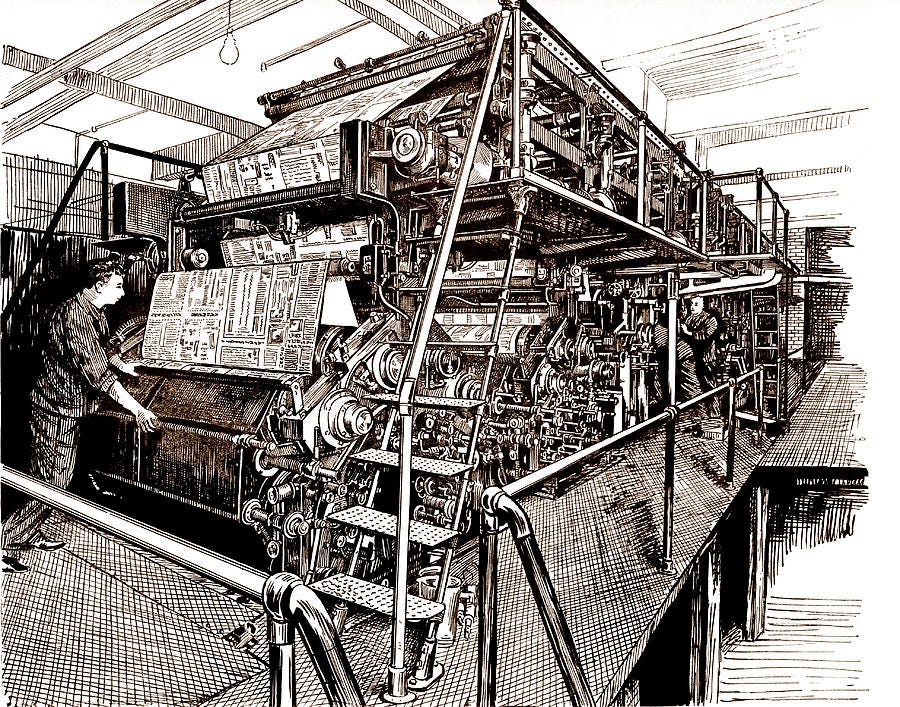Memo to Tribune Rescuers: First Thing You Do, Stop Printing the Papers
Thanks for saving your local newspaper. Now do something hard, before it gets much harder.
Welcome to Second Rough Draft, a newsletter about journalism in our time, how it (especially its business) is evolving, and the challenges it faces.
Among the very bad things that have happened to local newspapers over the last 16 years, likely the worst has been the slide of so many into the hands of hedge funds. More than half of the nation’s newspapers by circulation are now owned by such funds. The reason this is such bad news is that these investors have two distinguishing characteristics: 1) they care about returns on their investment and nothing else, and 2) they insist that the returns come quickly. So concerns about the effect on underserved communities don’t count, and investment for the long run is out of the question.
Now, in cities ranging from Chicago to Orlando to Baltimore to Hartford, potential local savior-owners may be starting to emerge for some of these papers. They care about their communities, and they want to save these imperiled journalistic institutions. It’s impossible not to root for their gaining control of as many of the papers as possible.
If you are one of these rescuers, I want to offer some free advice: as you soon as you get control, or even as a condition of doing so if possible, take the newspapers out of print, and go all-digital.
Why take this drastic step? These properties, especially as local standalones with the efficiencies that come from chain ownership stripped away, are likely close to or below the breakeven point. If they aren’t, they soon will be, as print circulation continues to hemorrhage and the advertising oligopoly of Facebook, Google and Amazon steamrolls along.
The “papers’” viable future, if there is one, rests in some combination of direct reader support (through donations, paywalls or both) and the largesse of new local backers like you.
But none of your cohort of putative owners has the wealth of Jeff Bezos, who literally need not care how much the Washington Post costs him-- it couldn’t conceivably be enough to affect him or his philanthropy materially. Rather, you are situated more similarly to Patrick and Nika Soon-Shiong at the Los Angeles Times, John and Linda Henry at the Boston Globe and even the Lenfest Institute in Philadelphia, generous backers, but also conscious of the limits of even their considerable resources. To put a fine point on it, people like you able and willing to lose money to save the local paper, but only so much.
Which brings us back to print. Those of us once in the print-and-digital newspaper business have long understood, and outsiders were always shocked to discover that as much as 80-85% of all expenses traditionally came in the process of marketing, printing and delivering the physical product. That left a relatively small fraction for news, which is, after all, the point of the enterprise. In digital publishing, it’s the other way around: one can aspire to devote 75% of spending to news.
And that’s my point, in a nutshell. If you have a finite amount of money you are willing to spend to save your local paper, you want maximum leverage, as they say in the money business. Digital publishing has much more leverage than print. More directly, every dollar you lose propping up the print edition, and delaying but certainly not preventing its demise, is one fewer dollar you will have available to reinvent the digital product, strengthening its content, perhaps building a paywall, attracting and soliciting—and deserving—reader support.
Better now than later
Plus, there’s a second reason to force this transition immediately upon assuming ownership: it’s likely to be unpopular.
There are readers, mostly older, who will find it difficult or impossible to switch from print to digital. While they are a relatively small minority of consumers (digital readership already swamps print at every hybrid publisher), they are likely to be vocal, and they may even include more journalists, perhaps the most vocal group of all. Then there are the printers and drivers unions. If you wait to give these groups the bad news about print, you will entirely own the decision, and they will do their best to make it painful for you. If you make it part of the price of your rescue, the psychic costs will likely be far smaller.
One significant caveat: In at least some markets, perhaps most, it may make business sense to leave one weekend edition in print for some few years to come. If that’s really so, by all means do it. But make sure it does. The revenue side will be tempting: it should be possible to shift a meaningful proportion of weekday print advertising to the weekend. Watch out for the expense side, however: printing and delivering one day a week requires much of the same infrastructure as doing so three or six or seven days.
And be very careful about offering false reassurances about the durability of the weekend paper. The trends which will result in its ultimate demise—including possible reader shifts away from central cities (and print circulation areas) as retirements accelerate for Baby Boomers and remote work becomes easier and more accepted—are likely to continue.
Congratulations on coming to the rescue, and welcome to newspaper publishing.





Correct argument. Painful but necessary. Of course the intermediate step that nobody seems to be undertaking is to make the digital product usable and readable. The Chicago Tribune's digital appearance in my cell phone is the worst -- so frustrating and visually distracting that I hardly ever go there, and I am a fully paid in subscriber. I don't know why I am paying them a monthly subscription fee for such a shabby reader experience.
Great advice. This absolutely has to be done, but the key is keeping your readers as you go through the transition. Many have done this poorly, though a few quite well. McClatchy did a great job of increasing digital usage while eliminating Saturday print. The Salt Lake Tribune has probably done the best job of this - going down to Sunday only while keeping most of their print subscription revenue. The formula includes everything from good digital marketing, easy-to-use digital products, and even call centers to walk print subscribers through the transition.